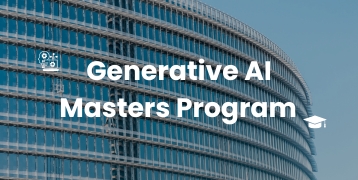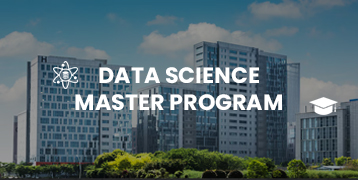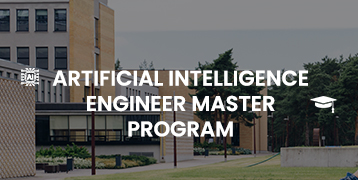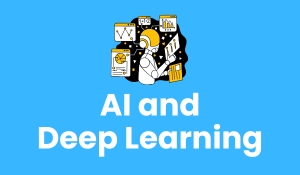
Introduction to AI and Deep Learning?
Artificial Intelligence (AI) is computerized human intellect that enables machinery to think, learn, and make choices. AI can help computers and systems reason, understand speech, choose, and analyze languages. AI applies algorithms and information in quantities as massive as millions to notice patterns and train in the long term. From virtual assistants to self-driving cars, artificial intelligence transforms businesses and everyday life. Its core technologies include computer vision, robotics, natural language processing, and machine learning. It continues to improve automation, innovation, and efficiency across industries as technology advances.
AI modules encompass various forms of artificial intelligence, while deep learning focuses on algorithms modeled after the human brain’s structure and function, specifically artificial neural networks. These algorithms are trained on large datasets to automatically learn data representations, features, and patterns, improving their performance and accuracy over time. Unlike traditional machine learning frameworks, deep learning frameworks can handle vast amounts of unstructured data such as text, speech, and images to generate predictions or insights.
The AI and deep learning Training revolution is revolutionizing several industries, including finance, healthcare, autonomous driving, and journalism. It propels applications from vision recognition to voice and driverless driving to virtual assistants, etc.
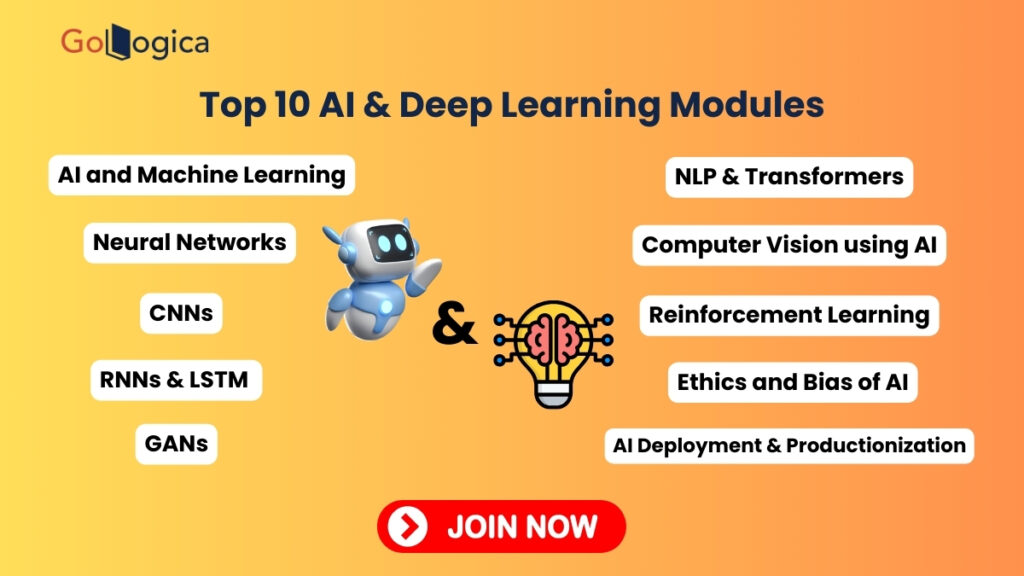
Top 10 AI and Deep Learning Modules:
The AI and Deep Learning Modules would typically include some of the most significant modules that are intended to help with the theory as well as the practicality of such technologies. Every module is intended to give the learners the tools and the knowledge that they require to construct, train, and deploy the AI models. Let us break down some of the basic modules that learners might be learning in an optimally planned training program.
AI and Machine Learning
Familiarizes learners with the basics of machine learning training (ML) and artificial intelligence (AI). They become aware of various forms of learning: reinforcement learning, unsupervised learning, and supervised learning and how they are used daily in decision-making, automation, and data analysis. The module also explains the distinction between AI, ML, and deep learning and where and how they overlap with and diverge from one another in real practice. Some of the experiments that would be conducted include constructing simple machine learning models like linear regression and classification models, where the learners may gain a bit of hands-on practical experience. The AI and Deep Learning Modules act as a foundation for advanced subjects in the way that they give the learners a good foundation in AI and ML technologies.
An example of machine learning in real life would be the recommendation system on websites such as Netflix, which recommends programs to watch based on your viewing history.
Neural Networks
Neural networks form the foundation of deep learning fundamentals and the majority of AI systems. This module introduces the organization and working of neural networks and their most significant components such as neurons, layers, weights, and biases. Learners will understand how the data gets divided in a sequence of interlinked neurons so that the network is able to make predictions or classifications. Decreasing the errors by choosing the weights and the biases is one of the key things to perform during the training of neural networks. This is done using back propagation, a step-by-step procedure where the network learns through a comparison of expected and actual outputs and adjusts its parameters accordingly. By learning this procedure, learners can gain the required basic knowledge to train and develop quality deep learning models.
An example of a neural network for facial recognition can analyze pixel values of images in multiple layers to identify features such as the eyes, nose, and mouth. The model recognizes the face from features.
Advanced Neural Networks and Convolutional Neural Networks (CNNs)
Advanced neural networks are covered in this module and refer to specialized forms such as Convolutional Neural Networks (CNNs) that are effective at image processing tasks. It works by convolving convolutional layers with filters over input data so they can learn to identify significant features such as edges, patterns, and textures from images. The CNNs naturally possess the ability to learn spatial hierarchies of features and are thus of interest to natural problems such as image interpretation in health, self-driving car navigation, and object recognition. CNNs have revolutionized companies to enable computers to analyze and comprehend visual data with unprecedented accuracy to give rise to path-breaking computer vision, self-driving cars, and large-scale medical diagnostics.
An example of CNNs is used intensively in autonomous cars to detect obstacles, pedestrians, and traffic lights so that they can move safely.
| Learn more information from the GoLogica “AI with Deep learning Training“ |
Recurrent Neural Networks (RNNs) and Long Short-Term Memory (LSTM) Networks
RNNs learn to handle sequence data, i.e., time-series or natural language text, by remembering something at one time step to the next time step. RNNs are capable of remembering short-term dependencies but cannot remember long-term dependencies since the vanishing gradient problem does not allow them to do so. Long Short-Term Memory (LSTM) networks, which are a form of RNN, overcome this issue by adding gates to the information flow so that they can hold useful information for longer periods. This allows LSTMs to be effective at context understanding over time tasks such as speech recognition, sentiment analysis, and language translation. LSTMs are now a basic building block for natural language processing and sequential data analysis.
An example in a language translation task, an LSTM network translates a sentence in a source language and produces the target sentence in a target language from the learned representation.
Generative Adversarial Networks (GANs)
Generative Adversarial Networks (GANs) are a new deep learning tool. A GAN is made up of two competing neural networks, the discriminator and generator. The task of the generator is to produce real data and the task of the discriminator is to distinguish between real data and generated data. This competition between these two networks, or process of adversaries, compels the generator to improve with time. While the generator is training, it learns more and more effectively to generate extremely realistic images, videos, and data. GANs have changed image creation fields, deepfakes, and creative entrepreneurship as they allow machines to produce quality and realistic content without intervention.
An example of GANs was also used to generate realistic human faces, portraits, and deep fake videos that caused ethical problems but also revealed the capability of deep learning in generating content.
Natural Language Processing (NLP) and Transformers
Natural Language Processing (NLP) deals with how to make machines capable of understanding and processing natural language. The topic covers the fundamentals of text analysis, sentiment analysis, tokenization, part-of-speech tagging, and named entity recognition. Because of the presence of models like BERT and GPT at the time when transformers achieved the breakthrough, NLP has grown exponentially. These models can provide tremendous contextual information, hence are efficient in performing tasks like language translation, text summarization, and question answering with complete accuracy. Models that are conceived out of transformers are designed to process language more sophisticatedly, therefore, highly efficient in executing most NLP operations. This progression in NLP techniques has greatly enhanced machine understanding of human language, enabling more natural and intelligent interactions between humans and machines.
An example of Chatbots, like OpenAI’s GPT models, can hold conversations and provide helpful responses by processing natural language input in a context-aware manner.

Computer Vision using AI
Computer vision is a type of artificial intelligence that enables machines to interpret and make decisions based on visual information. Undergraduates in this module study basic skills such as image classification, where images are categorized by computers, object detection where objects in images are identified, and semantic segmentation where images are divided into semantically meaningful regions. The module is also covered with more advanced topics such as image captioning where computer-generated text describes images, and visual question answering where computer-generated answers give answers to questions based on visual information. These methods enable computers to read, understand, and interpret visual videos and images, and for that reason are needed for applications such as self-driving cars, medical imaging, and facial recognition.
An example Self-driving cars heavily depend on computer vision to recognize pedestrians, road signs, and billboards. They make instant driving judgments using a deep learning architecture.
Reinforcement Learning
Reinforcement Learning (RL) is a machine learning paradigm that teaches agents to make decisions by interacting with their surroundings. The agent is punished or rewarded depending on its action, driving the agent towards optimal decision-making. Some of the most important algorithms used by RL are Q-learning, policy gradient techniques, and Deep Q-Network (DQN). These algorithms allow agents to learn how to improve their actions step by step. RL is extensively used in applications ranging from robotics so that machines may learn to act through trial and error and learning, to playing games (e.g., AlphaGo), and autonomous systems, e.g., autonomous vehicles. The more skilled their strategy is, RL agents can optimize performance in uncertain, dynamic environments.
An example of DeepMind’s AlphaGo that had beaten world champions at the game go employs reinforcement learning to learn the optimal strategy by trying out in simulated computer games.
Ethics and Bias of AI
Since there has been proliferation of AI and deep learning technology globally, it is only natural to be mindful of their ethical considerations. The module educates on core subjects like algorithmic bias, data privacy, and misuse of AI systems. It emphasizes responsible and ethical use of AI, which makes the learners think about how such types of technologies impact fairness and transparency in making decisions. All the topics are intended to ensure that AI systems do not become biased, data privacy, and there is accountability for AI systems. It is recommended that the learners take into account the social and ethical duty of developing and deploying AI systems in a way that benefits everyone equally without any damage in terms of discrimination, privacy invasion, or excessive usage.
An example of facial recognition system biases have been reported to have been debated, where models developed with predominantly white populations become redundant with minorities and create problems of fairness and equality.
AI Deployment and Productionization
This module educates one on productionizing and deploying artificial intelligence models to be used in real life. It educates one on model optimization methods in an effort to optimize them for efficiency and effectiveness as well as challenge enormous amounts of data needed for training and testing them. How to utilize cloud platforms like AWS, Google Cloud, and Microsoft Azure in order to proceed with AI solutions for models to learn under growing demands will be the way learners will be instructed. How to apply best practices in monitoring and running AI models in production, e.g., reducing concerns like model drift, usage of resources, and performance, is included in the module.
For instance, a recommendation system that an AI generates for an online store needs to be installed and tested regularly so that it keeps getting updated continually with changing consumer trends.
AI and Deep Learning Modules Applications in the Real World
AI and Deep Learning Modules and technologies have revolutionized business, and the success has been record-breaking, enhancing efficiency, precision, and productivity. Medical deep learning algorithms have applications in the early diagnosis of disease, medication prescription, and developing customized treatment plans. Advancements improve patient care and improve healthcare accessibility.
Artificial intelligence Training has transformed industries such as fraud detection, which can detect suspect behavior in milliseconds by rummaging through enormous amounts of data. Artificial intelligence also drives trading algorithms that place high-speed trades on real-time market information, and is one of the prime drivers of credit scoring, providing more accurate evaluations of risk.
AI is also revolutionizing natural language processing (NLP), such as context-sensitive voice-enabled virtual assistant services like Siri and Alexa. AI-driven sentiment analysis helps organizations determine the sentiment of the customers for their service and accordingly implement respective adjustments.
Furthermore, areas such as autonomous vehicles, RPA, and AR depend solely on AI and deep learning and hence get smarter and wiser systems. Now AI has shifted out of its theoretical stage and firmly set foot in our everyday life with deep impact towards the way we discuss technology, work, and life.
Career Opportunities and Salaries
The growth rate of experts in AI and deep learning is at an extremely high rate with newer technologies being adopted by companies. Organizations from multiple sectors such as technology, health care, finance, and automobiles are scouting for machine learning professionals, AI developers, data science, and deep learning engineers. Some of the most sought-after jobs today include AI Developer, Deep Learning Engineer, Machine Learning Researcher, and Data Scientist.
Remuneration for AI careers is similar and experience, geography, and title level dependent. Aside from most individuals in these categories earning six-figure salaries, the highest of those are Machine Learning Engineers and AI Researchers. As AI becomes the infrastructure itself within businesses, never have opportunities existed for immediate career progression and monetary increase. Having a professional life in AI and deep learning not only makes one face economically profitable earning alternatives, but also exposes one to an opportunity where one can implement the latest technology that is remodeling the future.
Course Information
| Program Name | Duration | Fee | View Details |
|---|---|---|---|
| Artificial Intelligence Engineer Master’s Program | 24 Weeks | ₹60300/- | Enroll Now |
| Generative AI Course Master’s Program | 48 Weeks | ₹72900/- | Enroll Now |
| Machine Learning Master’s Program | 48 Weeks | ₹72900/- | Enroll Now |
| AWS Cloud Architect Training Course | 24 Weeks | ₹68400/- | Enroll Now |
About GoLogica
GoLogica offers advanced AI and Deep Learning Training to enable experts to be competent and proficient enough to be successful in the fast-evolving world of artificial intelligence. The entire training procedure covers crucial topics such as neural networks, machine learning algorithms, deep learning techniques, and natural language processing. By the end of this course, the learners will have hands-on experience in developing and constructing deep learning models that will enable them to implement AI technologies in real-time problems.
The training is properly structured, which supports practical application and theory. The training is imparting extensive knowledge in Python programming, TensorFlow, Keras, and other advanced industry-applied AI software on priority-demand future technologies. Other primary areas regarding necessary model optimization, testing, and preprocessing data, which are fundamentals in AI construction, have been covered by the training.
After successful completion of training on AI and Deep Learning, the student receives a GoLogica certification on the acquired skill that is in highest demand among job seekers. The certification is accepted everywhere by industry leaders from all industries and indicates the student’s ability to apply AI technologies in any industry from healthcare to banking. Similar to the fact that more demands are required in the field of AI experts, this certification provides access to limitless career opportunities in AI as well as deep learning.
Conclusion
AI and Deep Learning Modules are at the forefront of technological innovation, with applications that span virtually every industry. Understanding the fundamentals and modules of AI and deep learning is crucial for anyone looking to enter this exciting field. By mastering concepts like neural networks, computer vision, NLP, and reinforcement learning, you’ll be well-equipped to build the next generation of intelligent systems.
For all those willing to learn and implement this practice, selection of an aptly designed course in deep learning and AI will be the best choice that will make you competent enough to become a legacy. You can be a member of the era of artificial intelligence and develop future technology with the right skills and capability.
Related Article:
AI and Deep Learning Tutorial: Everything you need to know
Deep Learning Fundamentals Interview Questions And Answers
Deep Learning Interview Questions And Answers
Artificial Intelligence: Future of AI- Trends, Impacts, and Predictions

